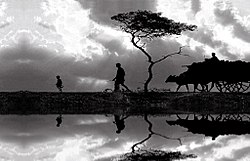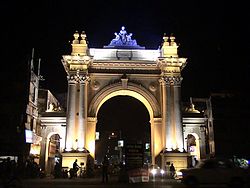Rarh region
Rarh
Rāḍha | |
|---|---|
Geographical region | |
|
From top down, left to right: Rural scenery from UTC+5:30 (IST) | |
| Vehicle registration | WB-11,WB-12,WB-14,WB-15,WB-16,WB-18,WB-29,
WB-30,WB-31,WB-32,WB-33,WB-34,WB-36,WB-37, WB-38,WB-39,WB-40,WB-41,WB-42,WB-44,WB-53, WB-54,WB-55,WB-56,WB-57,WB-WB-58,WB-67, WB-68[citation needed] |
| Major Cities | Asansol, Bardhaman, Dhanbad, Durgapur, Jamshedpur, Ramgarh, Ranchi |
| Civic agency | Government of West Bengal, Government of Jharkhand, Government of Odisha |
Rarh region (Bengali pronunciation:
The Rarh region historically has been known by many different names and has hosted numerous settlements throughout history. One theory identifies it with the powerful
Etymology and names
Rāḍha (
In a 1972 thesis, the researcher Amalendu Mitra traced the origin of the word Rarh to "lāṛ", the
"
Many aspect of Rarh are found in these books entitle as 'Subarnarekha hoite Mayurakshi[6] and Rarher Mantrayan[7] authored by Maniklal Sinha . Rarher Mantrayan[7][8] contains the ancient manuscripts of tantra and mantra, raveling various villages, and mixing with 'Mantrayanis' in Rarh. Whereas, Subarnarekha hoite Mayurakshi[6] is based on the tribal lifestyle , introducing various tribes, their festivals, clothing's, culture of Hazaribag, Singbhum, Manbhum, Dhalbhum Shikarbhum , Santal Pargana and Bankura that are situated in the basin of the river Subarnarekha. The author also discussed about the landscape of those laces and the influence of Buddhism on the tribal religion.
Geography
The Rarh region lies between the
Low-level
The major rivers in the region include
West Rarh's Bagri river is a fertile, low-lying alluvial tract. Rice, jute, legumes, oilseeds, wheat, barley, and mangoes are the chief crops in the east; extensive mulberry cultivation is carried out in the west.[9]
Rarh has several
Extent
According to Britannica, the Rahr plains cover parts of the following districts, divided into northern and southern Rarh by the Damodar river:[13]
- Northern Rarh: Murshidabad, Purba Bardhaman, Paschim Bardhaman, and Birbhum
- Southern Rarh: Purba Medinipur, Paschim Medinipur, and Bankura

P. R. Sarkar defines the Rarh region as follows:[16]
- East Rarh consists of roughly of the following districts:
- Western Murshidabad
- Northern Birbhum
- Eastern Burdwan (Bardhaman)
- Nadia
- Hooghly
- Howrah
- East Midnapore (Medinipur)
- Indas of Bankura district
- West Rarh consists of the following districts:
History

The earliest reference to Rāḍha
One theory identifies Rarh with the powerful
The legendary Sri Lankan chronicles
The earliest epigraphic evidence to Rāḍha probably appears in an inscription from Mathura. This inscription states that a Jain monk from the "Rara" country erected a Jain image. A Khajuraho inscription mentions that the Chandela ruler imprisoned the wives of the rulers of various kingdoms, which included Rāḍha.[2]
The 12th century Naihati copper-plate inscription of the Sena ruler Vallalasena mentions Rāḍha as the ancestral place of his dynasty.[2]
Historical extent
Various ancient and medieval region offer clues about the location and historical extent of the Rarh region. The Bhuvaneshvara inscription of Bhatta Bhavadeva, a 12th-century minister, describes Rāḍha as "a waterless, dry and woody region". This description suits the western part of Bengal. The 16th century Digvijayaprakasha suggests that Rāḍha was located to the north of the
According to Rupendra K Chattopadhyaya of Banglapedia, Rāḍha "probably included a large part of the modern Indian state of West Bengal".[2] According to historian André Wink, the Rāḍha division of the Pala-Sena era corresponds roughly to the modern Bardhaman district.[20]
Divisions
The 9th-10th century literature and inscriptions and literature mention two divisions of Rāḍha: northern (Uttara) and southern (Dakṣiṇa). Rupendra K Chattopadhyaya (in Banglapedia) believes that these roughly correspond to the Subbhabhumi and Vajjabhumi mentioned in the ancient Jain literature.[2] The 17th century scholar Nilakanatha mentions Suhma as a synonym of Rāḍha. However, as Subbhabhumi is a corruption of Suhma, it appears that Suhma referred to only a part of the ancient Rāḍha region.[21]
Uttara Rāḍha
A 6th century CE inscription of the Chola king Devendravarman is the earliest inscription to mention Uttara Rāḍha. The 12th century Belava copper inscription of Bhojavarman states that Bhatta Bhavadeva was born in the Siddhala village (modern Siddhalagram) of Uttara Rāḍha. The 12th century
Based on these records, Rupendra K Chattopadhyaya believes that the Uttara Rāḍha included the western parts of the modern
The archaeological sites located in the historical Uttara Rāḍha region include Rajbadidanga, Gitagram, Paikor, Batikar, Bahiri, Kagas, Kotasur, and Vallala-rajar-dhibi (Ballal Dhipi).[2]
Dakṣina Rāḍha
Dakṣina Rāḍha appears as a distinct unit in several inscriptions, including the 10th century Gaonri inscription of
Rupendra K Chattopadhyaya theorizes that the Dakṣiṇa Rāḍha covered a large of part of West Bengal lying between the Ajay and Damodar rivers. This includes large parts of the later Bardhaman, Howrah, and Hughli, and Burdwan districts. The southern boundary of Dakṣiṇa Rāḍha may have extended to the Rupnarayan River, and its western boundary extended beyond the Damodar river into the present-day Arambag subdivision.[2]
The archaeological sites that formed part of Dakṣina Rāḍha include:
Notable people of Rarh
Rarh presented human society the first philosopher Maharishi
See also
References
- ^ a b Rahul Peter Das 1983, p. 664.
- ^ a b c d e f g h i j k l m n Rupendra Radha 2012.
- ^ Shyuam Chand Mukherji 1966, pp. 35–36.
- ^ a b Rahul Peter Das 1983, p. 669.
- ^ Dineschandra Sircar 1971, p. 171, 215.
- ^ a b c Singha, Maniklal (1988). Subarnarekha hoite Mayurakshi (in Bengali). Bishnupur: Bangiya Sahtya Parisad: Bishnupur. Bankura.
- ^ a b c Singha, Maniklal (1979). Rardher Mantrajan (in Bengali). Bishnupur: Sri Chittaranjan Dasgupta.
- ^ S2CID 213713375.
- ^ a b "Rarh". Encyclopædia Britannica. Retrieved 26 August 2012.
- ^ Students Britannica 2000, p. 239.
- ^ a b Anita Roy Mukherjee 1995, p. 22.
- ^ Balai Chandra Das 2016, p. 20.
- ^ a b c Students Britannica 2000, p. 240.
- ^ Praṇaba Chattopadhyaya 2004, p. 16.
- ^ Anita Roy Mukherjee 1995, pp. 22–23.
- ^ OCLC 277280070.
- ^ a b Nitish K. Sengupta 2011, p. 28.
- ^ a b Dineschandra Sircar 1971, p. 172.
- ^ Mohammad Yusuf Siddiq 2015, p. 27.
- ^ André Wink 2002, p. 257.
- ^ Rupendra Suhma 2012.
Bibliography
- André Wink (2002). Al-Hind, the Making of the Indo-Islamic World. BRILL. ISBN 0-391-04173-8.
- Anita Roy Mukherjee (1995). Forest Resources Conservation and Regeneration: A Study of West Bengal Plateau. Concept Publishing Company. ISBN 978-81-7022-562-1.
- Balai Chandra Das; Sandipan Ghosh; Aznarul Islam; MD. Ismail (2016). Neo-Thinking on Ganges-Brahmaputra Basin Geomorphology. Springer. ISBN 978-3-319-26443-1.
- ISBN 978-81-208-0690-0.
- Gouripada Chatterjee (1987). History of Bagree-Rajya (Garhbeta). Mittal. p. 7. ISBN 978-81-7099-014-7.
- Mohammad Yusuf Siddiq (2015). Epigraphy and Islamic Culture. Routledge. ISBN 978-1-317-58746-0.
- Nitish K. Sengupta (2011). Land of Two Rivers: A History of Bengal from the Mahabharata to Mujib. Penguin Books India. ISBN 978-0-14-341678-4.
- Praṇaba Chattopadhyaya (2004). Archaeometallurgy in India: Studies on technoculture in early copper and iron ages in Bihar, Jharkhand, and West Bengal. Kashi Prasad Jayaswal Research Institute.
- Rupendra K Chattopadhyaya (2012). ISBN 978-984-32-0584-1.
- Rupendra K Chattopadhyaya (2012). ISBN 978-984-32-0584-1.
- JSTOR 40460739.
- Students' Britannica India. Encyclopaedia Britannica / Popular Prakashan. 2000. ISBN 978-0-85229-760-5.
- Shyuam Chand Mukherji (1966). A Study of Vaiṣṇavism in Ancient and Medieval Bengal. Punthi Pustak. OCLC 220444592.






